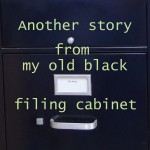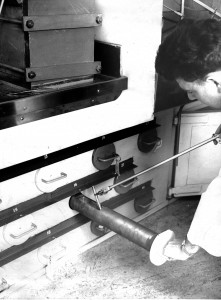Tooth Fairy Tests for Strontium-90
While he was completing his degree, my husband Tony worked as a physicist at New Zealand’s National Radiation Laboratory in Christchurch. One of his tasks was testing for the presence of the radioactive isotope Strontium-90 in children’s milk teeth This 1960 photograph shows him working in the lab.
Since the end of World War II in 1945, the United States, along with its allies France and Britain, used the Pacific region north of New Zealand as a testing ground for nuclear weapons. By the mid-1950s, casual attitudes about fallout from these tests had given way to concern. In 1957 the New Zealand Government charged its Department of Health with monitoring environmental radioactive contamination in New Zealand and the Pacific areas with which New Zealand was associated. Since the National Radiation Laboratory in Christchurch was already monitoring radioactive pollution and controlling the safe use of ionizing radiation in medicine, education, research and industry, it seemed a logical extension to extend its responsibilities to collecting samples, analyzing and interpreting data on environmental levels of radioactivity.
The idea of using of children’s milk teeth most likely came from the Baby Tooth Survey. This project was started in the US by the Greater St. Louis Citizens’ Committee for Nuclear Information, in conjunction with Saint Louis University and the Washington University School of Dental Medicine, and inspired similar initiatives in other parts of the world.
Strontium-90, which is chemically similar to calcium, is absorbed from water and dairy products into bones and teeth, and has been linked to bone cancer and leukemia.
 In New Zealand, evidence from the National Radiation Laboratory’s monitoring efforts helped moved the country toward opposition to French nuclear tests at Mururoa and to American warships’ visits to New Zealand.
In New Zealand, evidence from the National Radiation Laboratory’s monitoring efforts helped moved the country toward opposition to French nuclear tests at Mururoa and to American warships’ visits to New Zealand.
—–
Maureen is exploring the contents of an old black filing cabinet in her attic, which contains 55 years of her writing notes and memorabilia.

How can I get dental testing for Strontium-90
These posts are a treasure. Thanks for sharing with us, Maureen!
Clearly that filing cabinet is in reality a treasure chest.
I forwarded your post to my son Stephen, who has worked in the area of nuclear non-proliferation for the past 25 years.
Keep writing. I look forward to more gems.
Janet, to answer your question: Radioactivity monitoring in New Zealand is ongoing. You’ll find a number of useful reports at http://www.health.govt.nz/search/results/environmental%20radioactivity
What were the results of the tests? Was STronium 90 detected in the baby teeth at higher than healthy levels? What as been the follow-up since the 60s. Those are the questions that spring to my mind.
Keep them coming
My father (not Tony’s father) used to argue that the French tests had an adverse effect on the weather in NZ.
I think Tony must have been a very good tooth fairy. And, how rewarding to know that some of the research has kept NZ nuclear-free. Looking forward to seeing what else you unearth in the old black filing cabinet (Almost sounds like the title of a Nancy Drew mystery.)
Wow – very interesting. I thought that the world was in denial about nuclear contamination. Now I see that governments were very much at work “behind the scenes” of what ordinary citizens may have heard/read through mainstream media. Concerning health effects of exposure. And yet, industry always pushed the nuclear solution as the world’s answer to energy demands.
While you were growing up in NZ, contamination was also spread over a great deal of America’s western plains. And likely many other “top secret” regions of our precious universe.
Invisible, insidious contamination that manifests generations forward.
Love your black filing cabinet and its treasures!